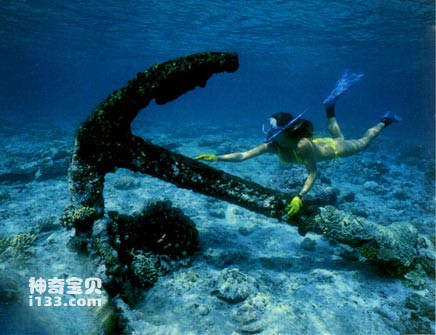On the southern coast of the Mediterranean Sea, there is a place called Tunisia. In the nearby Madia Sea area, 40 meters underwater, many marble columns were found buried in the mud. According to historians, they are cultural relics from 2,000 years ago. After the discovery was announced, Austrian archaeologists became interested and immediately organized divers to visit the site. There they discovered some ancient arch bridges and rare large buildings. After further research, it was believed that this was an ancient city. In the long history of mankind, due to natural and man-made disasters such as sea and land changes, earthquakes, volcanoes, storm surges, floods, and wars, some cities, villages, towns, ports, etc. have sunk to the bottom of the sea; as for those who have died due to strong winds, huge waves, iceberg collisions, naval battles, etc. There are even more ships with fish bellies. With the improvement of science and diving and salvage technology, these treasures sleeping on the seabed will sooner or later be exposed to the world. In 1991, a joint expedition team composed of scientists from the former Soviet Union and Canada conducted a scientific investigation of the "Titanic" ship that had sunk at the bottom of the sea for 79 years, and produced 160 hours of video, recording in detail The changes that this luxury liner undergoes in the deep sea environment.

An ancient city sunk under the sea

The ancient Tarim ocean was full of life
"Titanic", on its maiden voyage from Southampton Port to New York in April 1912, unfortunately hit a huge iceberg and sank at the bottom of the North Atlantic 4,000 meters below, killing 1,500 passengers.
The ocean has existed on the earth for 4 billion years. During this long geological time, materials brought into the ocean by land rivers and the atmosphere, as well as things falling into the seabed during human activities, including soft sediment, dust, remains of animals and plants, cosmic dust, etc., Over the years and over time, there have been too many to count. Scientifically, these things are collectively called seabed sediments. On May 5, 1995, Xinhua News Agency reported that Chinese scientists discovered a huge marine oil field in the Tarim Basin. The Tarim Basin is located in the northwest inland of the motherland, covering an area of 560,000 square kilometers, almost as large as four Shandong Provinces. Scientists have verified that more than 100 million years ago, there was a rough ocean there. Later, due to the Himalayan orogeny, it was pushed down, squeezed and uplifted, turning from ocean to land, and finally turned into a desert. In the Tarim Ocean, the dense biota and organic matter buried in the large amount of sediments on the seabed turned into the large oil fields discovered today under the high pressure, high temperature and special stratigraphic environment. Oil is hidden 5,000 meters underground. A large part of these 5,000 meters of strata is seabed sediments, which have now become rocks or fossils.
animal tags:
We created this article in conjunction with AI technology, then made sure it was fact-checked and edited by a Animals Top editor.